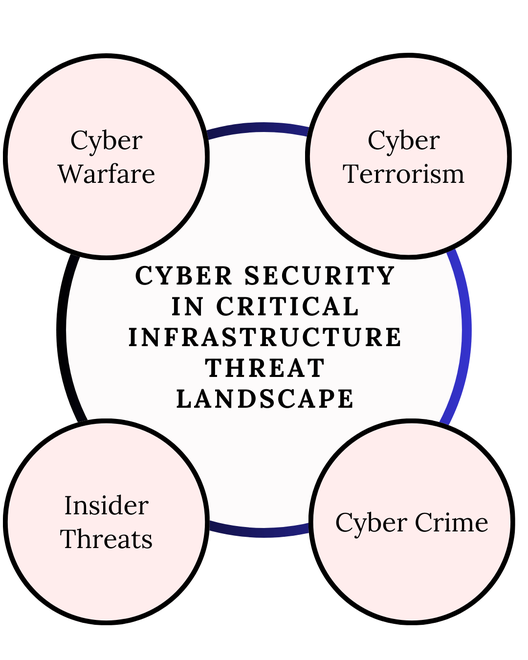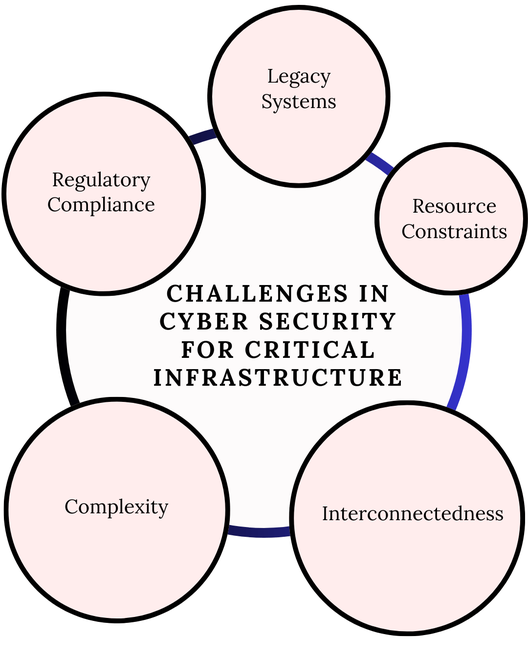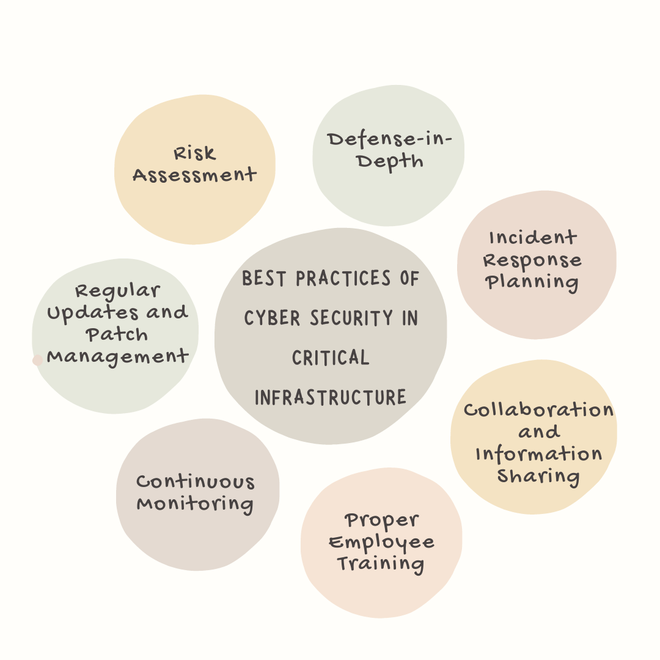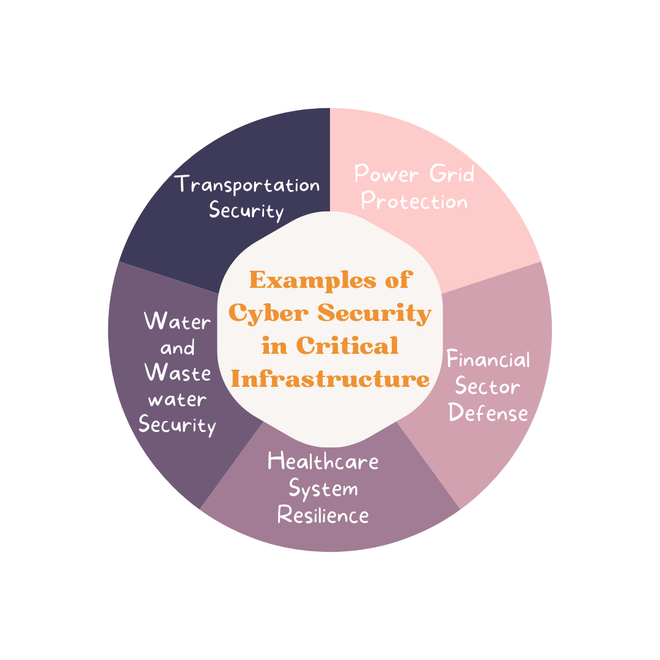Understanding Cyber Security in Critical Infrastructure
Last Updated :
26 Mar, 2024
The Cybersecurity features of critical infrastructure have rapidly emerged in a digital society and are doing more on online networks. Present-time civilization is largely based on a variety of networks and computer systems in which power supply systems, transportation infrastructure, hospitals, banks, and other institutions of the financial systems operate.
The hard practice of cyber security has another side of vulnerability wherein the dependence on digital technology may lead to a broken cyber defense system becoming one of the targets for cybercriminals. Cybersecurity in critical infrastructure is not only about technicality but it is a matter of historic priority to shrink the chances of economic crisis, public disorder, and national threat.
In this article, we will take a critical look at cyber security as it relates to the essential infrastructures with their challenges, advised methodologies or best practices, and some of the scenarios or examples in the real world where cyber security has been a problem.
What is Cyber Security in Critical Infrastructure?
The entire infrastructural operations of the economy and society are dependent on the safety of their vital systems networks and resources, and that is called cybersecurity in critical infrastructure. Operating these critical infrastructures against cyber-attacks is a must, and that is possible through putting in place high-quality and strict policies.
Critical infrastructure of cybersecurity simply put ways of a general security strategy aimed at maintaining the confidentiality, integrity, and availability of its related informational resources which are to be protected. It’s used to deny malicious users the opportunity to take advantage of vulnerabilities for their power objective goals. This calls for the protection of national governments from the risk of instigating cyberwarfare, resisting non-state individuals’ coordinating efforts for cyberterrorism, taking care of criminal syndicates on cybercrime undertakings, and separating malicious insiders or careless employees as insider threats.
Critical infrastructure has to be cyber-secured because the possible attacks can result in damaged public safety, might lead to disruption, and might lead to monetary loss. Initiatives need to be prioritized, and risks need to be evaluated. defenses have to be reinforced, as concerns that organizations need to handle. Sneaking in the midst, the cyber security of critical infrastructure is the guiding light that promotes the strength, dependability, and constant operation of these central systems that support modern civilization.
Cyber Security in Critical Infrastructure Threat Landscape
Cyber threats may compromise critical infrastructure and can come in many different forms, such as:

Threat Landscape in Critical Infrastructure
- Cyber Warfare: Cyber threats could be launched by states and actors granted state support to implement espionage, launching cyberattacks that collapse critical services or destroy advisory systems.
- Cyber Terrorism: Cyber terrorist groups and other non-state actors can engage in such attacks to create a sense of chaos, terror, and fear.
- Cyber Crime: Bypassing security systems poses an appealing opportunity, as organized crime groups exploit vulnerabilities in critical infrastructures to steal or demand money, or to produce service interruptions.
- Insider Threats: Insiders who are evil-minded or employees who are negligent with care are very close to serious risks. They can access vital systems by either exploiting some vulnerabilities or unintentionally leading to security lapses.
Major Challenges in Cyber Security for Critical Infrastructure
Challenges of cyber security for critical infrastructure, which include:

Major Challenges in Cyber Security for Critical Infrastructure
- Legacy Systems: The dominance of outdated systems is one of the biggest challenges to critical infrastructure cyber security. These outdated systems might be challenging to patch or upgrade as security was frequently overlooked during their creation. They are therefore simply a reward for hackers. These legacy systems often lack built-in features of security.
- Resource Constraints: Limitations of financial or budget constraints lead to conflicting objectives that might restrict the amount of money allocated to cybersecurity precautions, leaving critical infrastructure open to sophisticated cyberattacks.
- Interconnectedness: As the Critical infrastructure is networked or interconnected, it makes it more vulnerable to attack as a breach in one system might give access to others.
- Complexity: Critical infrastructure systems are often complex that’s why it is difficult to deploy thorough cybersecurity measures because systems are frequently complex, including a large number of components and stakeholders.
- Regulatory Compliance: Another layer of complexity and challenges arises due to complying with cybersecurity standards and laws, which forces organizations to manage a maze of requirements while preserving operational effectiveness.
Cyber Security in Critical Infrastructure Best Practices
Best practices of cyber security in critical infrastructure, which include:

Cyber Security Best Practices in Critical Infrastructure
- Risk Assessment: Risk assessing is the phase where the risk is identified, decided, and analyzed and this is known as the cyber security risk assessment process. Conducting routine risk assessment procedures to locate flaws in the cybersecurity environment, ranking the threats, and spending budgets wisely may be considered the best practice for the designing strategy of critical infrastructure.
- Defense-in-Depth: Cybersecurity Defense-in-depth means the deployment of one control feature, and the inclusion of another one, which is next to the previous security control. This design approach aims to lower the possibility of security breaches. One primary thing is to have a safety measure set up as an added layer and a backup in case threats arise. If the system is facing a security loophole, the community must respond with a counteraction strategy. The layering of security systems like intrusion detection systems (IDS), firewalls, access control, and encryption tools, provide another measure to scale back threats to critical infrastructure. Unlike the strategy of defending against only one cyber threat, the strategy of multi-layered security systems enables more responses to different kinds of cyber threats allowing the system to prepare itself in case it is attacked.
- Incident Response Planning: An official written prescription that summarizes an approach to data incidents such as breaches, stealing, cyberattacks, etc, and keeping information secure is an incident response plan. Planning policies are developed and tested and implementation of the incident response plans in a quick order to efficiently respond to cyber events as well as to minimize interruption and quick restoration is practiced.
- Collaboration and Information Sharing: Promoting joint work of government institutions, organizations, and foreign allies to transfer knowledge on cybersecurity practices and threat intelligence is supposed to be a maximum practice.
- Proper Employee Training: Another effective measure is appropriate education for the employees at all levels in cybersecurity, which will help employees recognize and struggle with possible threats such as phishing attacks or social engineering strategies.
- Continuous Monitoring: Adopting advanced monitoring tools to track intrusions timely, prevent attacks as well as initiate aggressive defense is the best way for the cybersecurity of critical infrastructure.
- Regular Updates and Patch Management: Keeping the installed software and systems up-to-date with the latest security patches and updates enables the system to locate known vulnerabilities hence reducing the amount of risk of exploitation in the system.
Examples of Cyber Security in Critical Infrastructure
Here are some examples of cybersecurity in critical infrastructure:

Examples of Cyber Security in Critical Infrastructure
- Transportation Security: The incorporation of encryption methods to protect military traffic management and communication networks such as the ones used in air, rail, and waterway transportation is a good example of cybersecurity in critical infrastructure, through adopting biometric authentication methods and using restrictions to prohibit unauthorized people from coming into critical assets such as airports and harbors.
- Power Grid Protection: Cyber security of critical infrastructure is a major need for power grid systems provided by electrical systems. Among these will be the installation of new types of firewalls and IDS (intrusion detection systems) that will have the ability to defend against online attacks that attempt network accesses with the intent to compromise power distribution, transmission, and generation infrastructure. Automated anomaly detection and traffic network monitoring also allow the detection of cyber breaches ahead of time, penetration testing, and vulnerability assessments, on the other hand, provide the necessary resilience to power plants against ever-increasing threats.
- Financial Sector Defense: Weak cybersecurity measures are dangerous in the financial industry, they can lead to data breaches or even financial losses. The cyberattacks can be against payment networks, banking systems, and financial transactions, so the industry must protect all of them. The management of cyber threats to banking and digital payment platforms which apply the most up-to-date fraud detection systems and anomaly detection systems is the prevention of fraudulent incidents being detected and bringing them to a halt. For secure financial transactions, the use of multi-factor authentication and tokenizing in conjunction with cybersecurity in critical infrastructure makes the online banking system stronger and more secure, ensuring the protection of customer data.
- Healthcare System Resilience: Cyber security is essential to the healthcare industry as it aims to prevent disruption to system reliability and data safety. One healthcare cybersecurity aims to secure EHRs, medical equipment, and telemedicine platforms from cyberattacks targeting healthcare systems by the deployment of strong cybersecurity measures. Although these technologies to some extent contradict the fundamental principles of the Health Insurance Portability and Accountability Act (HIPAA) regulations such as protecting the privacy of patients and the accuracy of data that is stored and shared across healthcare networks, the experts recommend data encryption and secure authentication methods to make these technological applications safe. Furthermore, the development of an emergency plan and an alternative provision of healthcare services in case of a cyber disaster might be important as it protects the health and security of the public when the infrastructure of a healthcare institution is affected by a cyber disaster by providing patient care and important medical service.
- Water and Wastewater Security: The guarding mechanisms of cybersecurity are necessary for guaranteeing the safety and security of critical infrastructure during the process of water and waste. Defenses such as segregating computers in the treatment facility and offsite secure access help put water and wastewater systems out of reach of cyber attacks. Providing means of defense from the manipulation of the leading units of Industrial Control Systems (ICS) by network whitelisting and firmware integrity tests is the target of cybersecurity technologies. To better guarantee a constant supply of water and sanitation services, protect people’s health, and be environmentally friendly, the dry run and cybersecurity training drills are undertaken.
Conclusion
As we come to the end of the article the cybersecurity of the critical infrastructures remains a vital problem that impacts in many ways the society which greatly depends on networked digital systems. Critical Infrastructure, as a vulnerable target for cyber-attacks, can have a devastating impact on national security, stating risks that can be translated into alternative views-situations, involving millions of those affected and the economy being compromised. The organizations might enhance their resistance of critical infrastructure to up-and-coming cyber-attacks. Furthermore, they ensure that a steady, friendly, and secure society is in place by studying what constitutes a cyber threat, developing feasible remedies and finally endorsing generally acceptable procedures.
Understanding Cyber Security in Critical Infrastructure – FAQs
Describe critical infrastructure in brief.
In terms of cybersecurity, critical infrastructure can be termed as those complex interconnected ecosystem which includes assets, systems, and networks that gives us the necessary functions which are required for our way of life such as transportation and communication systems, water and power lines, etc.
List common cyber threats to critical infrastructure and what are the different categories of threats?
Major threats to critical infrastructure include cyber warfare, cyber terrorism, cyber crime, and insider threats. Cyber threats in critical infrastructure is mainly classified into three different categories such as natural threats which includes the hazards like earthquake and tsunami, Human-caused threats that includes cyber attacks, rioting, explosions and bombing (also termed as terrrorism).The third category is Accidental and technological threats that includes transportation accidents & failures & infrastructural failures.
List the different challenges faced by cyber security in critical infrastructure.
Major challenges that are faced in critical infrastructure includes Legacy Systems, complexity, constraints related to resources, regulatory compliance issues, and interconnectedness.
Share your thoughts in the comments
Please Login to comment...